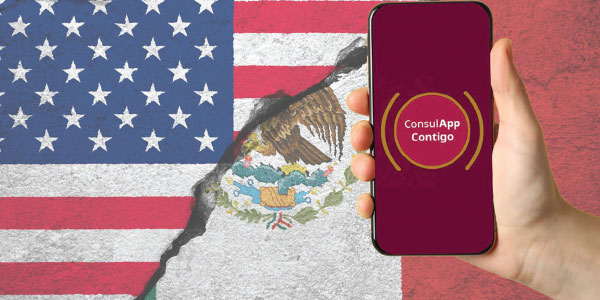
Healthcare providers struggle to meet migrant needs at the U.S.-Mexico border
By Tere Siqueira
The journey of migrants at the southern border of the United States has reached a critical and alarming point. Amidst scorching heat, inhumane policies, and life-threatening obstacles, the tragic stories unfolding at the border are a stark reminder of the harsh reality faced by those seeking refuge in the United States.
Emergency room doctor Brian Elmore, a resident physician in El Paso and co-founder of Clínica Hope, a free clinic for immigrants in Ciudad Juárez, Mexico, shared his experiences treating migrants victimized by the harsh border policies. In an op-ed piece for CNN, he detailed their life-threatening conditions, from heat strokes to devastating fractures.
Between mid-June and late July, El Paso endured over 40 consecutive days of temperatures exceeding 98.6 degrees Fahrenheit. The extreme heat led to the deaths of more than 100 migrants this year at the southern border of the United States, according to Jason Owens, chief of the U.S. Border Patrol. One week in July recorded 13 deaths and 226 rescues for dehydration and other heat-related issues.
Texas Governor Greg Abbott’s “Operation Lone Star,” purportedly aimed at securing the border, has worsened the already dangerous conditions for migrants. This includes erecting a barrier of buoys in the Rio Grande and extensive razor wire on the shores.
In one horrifying instance, a pregnant woman miscarried and became trapped in the razor wire. In another, a young girl fainted from heat exhaustion after being pushed back by the Texas National Guard as she attempted to pass through.
A police email, written to a supervisor and reviewed by Hearst Newspapers, also alleges that DPS soldiers were instructed not to provide water to migrants. “I think we have crossed the line of inhumanity,” concluded the officer.
The Justice Department has since sued the state of Texas, asserting that the floating barriers violate the Rivers and Harbors Appropriation Act. The legal dispute continues, highlighting the failures and complexities of U.S. immigration policy.
The inhumane treatment of migrants is not new. Since President Bill Clinton’s “prevention through deterrence” policy in the 1990s, nearly 10,000 migrants have died on the U.S.-Mexico border.
President George W. Bush’s administration constructed border barriers around El Paso, leading to countless injuries as desperate individuals attempted to scale them. President Donald Trump’s administration further expanded the border walls, leading to increased deaths and injuries from falls.
Even President Biden’s administration has fallen short of making the asylum system more humane, continuing problematic policies and adding further challenges for the most vulnerable at the border.
The devastating injuries seen along the border – sunstroke from the desert’s burning sun, skull or spine fractures from falling off the border wall, flesh torn by razor wire on the Rio Grande banks – are what Dr. Elmore calls “political pathologies.” These avoidable injuries directly result from policies designed to impose a high cost on those attempting to cross.
“I see and treat victims who are permanently weakened… with devastating injuries that will limit their ability to work and contribute to society and their families,” Dr. Elmore said.” It is encouraging to see hope and promise in the eyes of the immigrants I attend to.”
The tragedies occurring at the southern border demand urgent attention. The stories of resilience, hope, and belief in the promise of a better life are a reminder that the country’s immigration policy must rise to a higher standard of humanity.
El trato inhumano de los migrantes, peligro en la frontera
Proveedores de atención médica luchan por satisfacer las necesidades de los migrantes en la frontera entre EE. UU. y México
La travesía de los migrantes en la frontera sur de los Estados Unidos ha llegado a un punto crítico y alarmante. Entre el calor abrasador, políticas inhumanas y obstáculos mortales, las trágicas historias que se desarrollan en la frontera son un recordatorio contundente de la dura realidad que enfrentan aquellos que buscan refugio en los Estados Unidos.
El doctor Brian Elmore, médico de urgencias en El Paso y cofundador de la Clínica Hope, una clínica gratuita para inmigrantes en Ciudad Juárez, México, compartió sus experiencias tratando a migrantes victimizados por las duras políticas fronterizas. En un artículo de opinión para CNN, detalló sus condiciones de riesgo mortal, desde golpes de calor hasta fracturas devastadoras.
Entre mediados de junio y finales de julio, El Paso sufrió más de 40 días consecutivos de temperaturas superiores a los 37 grados Celsius. El calor extremo llevó a la muerte de más de 100 migrantes este año en la frontera sur de los Estados Unidos, según Jason Owens, jefe de la Patrulla Fronteriza de EE. UU. Una semana en julio registró 13 muertes y 226 rescates por deshidratación y otros problemas relacionados con el calor.
La “Operación Lone Star” del gobernador de Texas, Greg Abbott, supuestamente dirigida a asegurar la frontera, ha empeorado las peligrosas condiciones para los migrantes. Esto incluye la colocación de una barrera de boyas en el Río Grande y una barda de alambre de púas en las orillas.
En un trágico caso, una mujer embarazada sufrió un aborto espontáneo y quedó atrapada en el alambre de púas. En otro, una niña pequeña se desmayó por agotamiento debido al calor después de ser rechazada por la Guardia Nacional de Texas mientras intentaba pasar.
Un correo electrónico policial, escrito a un supervisor y revisado por Hearst Newspapers, también alega que se instruyó a los soldados de DPS que no proporcionaran agua a los migrantes. “Creo que hemos cruzado la línea de la inhumanidad”, concluyó el oficial.
Desde entonces, el Departamento de Justicia ha demandado al estado de Texas, alegando que las barreras flotantes violan la Ley de Apropiación de Ríos y Puertos. La disputa legal continúa, destacando los fracasos y complejidades de la política de inmigración de EE. UU.
El trato inhumano de los migrantes no es nuevo. Desde la política de “prevención mediante la disuasión” del presidente Bill Clinton en la década de 1990, casi 10,000 migrantes han muerto en la frontera entre EE. UU. y México.
La administración del presidente George W. Bush construyó barreras fronterizas alrededor de El Paso, lo que llevó a innumerables heridas cuando individuos desesperados intentaron escalarlas. La administración del presidente Donald Trump amplió aún más las paredes fronterizas, lo que llevó a un aumento de muertes y heridas por caídas.
Incluso la administración del presidente Biden ha quedado corta en humanizar más el sistema de asilo, continuando políticas problemáticas y agregando más desafíos para los más vulnerables en la frontera.
Las lesiones devastadoras observadas a lo largo de la frontera: insolaciones por el sol ardiente del desierto, fracturas de cráneo o columna al caer del muro fronterizo, carne desgarrada por el alambre de púas en las orillas del Río Grande, son lo que el Dr. Elmore llama “patologías políticas”. Estas lesiones evitables son el resultado directo de políticas diseñadas para imponer un alto costo a quienes intentan cruzar.
“Veo y trato a víctimas que quedan permanentemente debilitadas… con lesiones devastadoras que limitarán su capacidad para trabajar y contribuir a la sociedad y sus familias”, dijo el Dr. Elmore. “Es alentador ver esperanza y promesa en los ojos de los inmigrantes a quienes atiendo.”
Las tragedias ocurridas en la frontera sur exigen atención urgente. Las historias de resiliencia, esperanza y creencia en la promesa de una vida mejor son un recordatorio de que la política de inmigración del país debe elevarse a un nivel más alto de humanidad.









